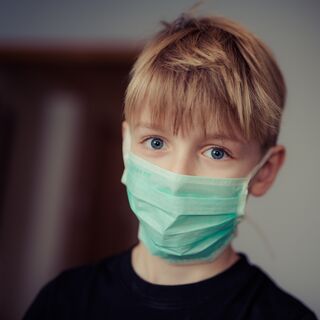Play
The Impact of Masks on Social and Emotional Development
How masks affect your child's development and what you can do about it.
Posted August 26, 2021 Reviewed by Chloe Williams
Key points
- Many parents and caregivers have raised concerns that wearing masks might negatively impact the social and emotional development of children.
- Research suggests that seeing the mouth is not essential for language development, and children can read most expressions on masked faces.
- Parents and caregivers can take steps to compensate for any negative impact of masks on development, such as using a loud and clear voice.
The American Academy of Pediatrics (AAP) recently announced that they recommend that children over the age of 2 years and teachers wear face masks for the upcoming 2021-2022 school year to reduce the transmission of COVID-19.
Yet, many parents and caregivers are concerned about the potential long-term impacts of wearing masks on a child’s language and social-emotional development. Does research give us any insight into the validity of these concerns?

Will masks impact my child’s language development?
Infants begin looking at the mouth region in the first few months of life and rely heavily upon visual cues from the mouth in order to effectively learn language. In particular, research finds that infants who look at the mouth more frequently while an adult is talking show an increased vocabulary as toddlers. However, being able to see the mouth is clearly not essential for language development, since even children with severe visual impairments are able to develop language with relative ease.
However, some parents and caregivers may wonder about the extent to which young children can even comprehend language when adults around them are wearing masks. Reassuringly, a recent study found that infants and toddlers do not have difficulty understanding familiar words when spoken through a normal surgical mask, yet did show difficulty understanding words through a clear face shield. The authors suggest that clear face shields may cause distortion of visual cues from the face making the word difficult to understand.
In summary, being able to see the mouth is important but not essential for language development and your child can likely understand most speech through a typical mask.
Will masks impact my child’s emotional development?
Many parents and caregivers have also raised concerns that masks might impact children’s ability to read emotions from faces and therefore negatively affect emotional development. Research shows that it is possible for children as young as 3 years to determine emotional expressions from only seeing the eyes. However, as might be expected, children are less accurate at determining the emotional expression from the eyes alone versus the whole face. Research also shows that adults and children rely on the mouth to decode emotion when an expression is unclear.
Interestingly, not seeing the mouth makes it disproportionately harder to recognize positive emotions and recent research indicates that masks make positive expressions seem less happy, suggesting that children might be less likely to perceive positive emotions in others when they are wearing masks.
Another recent study found that both adults and children (3 to 8 years old) show impaired ability to recognize emotions when others are wearing masks. However, this effect was particularly seen in children aged 3 to 5 years. Difficulty reading facial expressions for preschoolers is particularly impactful since preschool children are typically not yet able to also consider the situation when interpreting emotions, as adults and older children can.
Toddlers and infants are also highly influenced by their parent or caregiver’s emotions and use something called “social referencing” to check in with their parent/caregiver’s emotions to understand how they should behave in social situations. When adults are wearing masks, social referencing is very difficult. Masks may also disrupt spontaneous emotional mimicry (a phenomenon in which an individual automatically imitates the emotional expression of others). Spontaneous facial mimicry is important for recognizing emotions and the development of empathy.
In summary, children can likely still read some emotions from masked faces, but it may be more difficult particularly for young children, and wearing masks may impact processes important for emotional development, such as social referencing and emotional mimicry.
How can parents and caregivers promote children’s language and emotional development during this time?
Parents, caregivers, and teachers can try to compensate for any negative impacts of mask-wearing on language and emotional development with the following strategies:
- Spend increased time face-to-face at home (or when you can safely remove your mask). Sing songs, play games, and use their favorite toys to try to keep their attention on your face.
- Use increased language whenever you can. Narrate what you are doing and what your child is doing, play word games, sing, and read books.
- Use other cues to help children understand your language or emotions when wearing masks, such as using a more animated inflection when you speak, making eye movements that coordinate with your speech, and using gestures and voice inflections to show emotion. Teach your children to do the same. Research shows that adults and children rely on the mouth to decode emotion when the emotion is unclear so exaggerate your emotions whenever you can.
- Use a loud and clear voice so that children can understand you through a mask. Reduce any distractions or background noise.
- Practice making different types of faces with children while unmasked. Then move on to playing a modified “peekaboo” with your mask (covering your mouth instead of your eyes) while making different expressions. Your child will then learn other features associated with different emotions.
- While wearing a mask, play a “guess what kind of face I’m making” or a "guess what I'm saying" game. Tell them to watch your eyes and eyebrows, listen closely to your voice, and pay attention to your hands to guess correctly.
- Stay positive. Learning how to interpret language and read emotions from masked faces may ultimately enhance your child’s social and emotional development since they may learn to notice more subtle social cues, such as tone of voice and body language.
In conclusion, this research does not indicate that children should forgo wearing masks. Rather, it suggests that we also need to consider our children's social and emotional development, in addition to their physical health, during this time.
References
Curby, K. M., Johnson, K. J., & Tyson, A. (2012). Face to face with emotion: Holistic face processing is modulated by emotional state. Cognition & Emotion, 26(1), 93-102.
Drimalla, H., Landwehr, N., Hess, U., & Dziobek, I. (2019). From face to face: the contribution of facial mimicry to cognitive and emotional empathy. Cognition and Emotion.
Franco, F., Itakura, S., Pomorska, K., Abramowski, A., Nikaido, K., & Dimitriou, D. (2014). Can children with autism read emotions from the eyes? The eyes test revisited. Research in Developmental Disabilities, 35(5), 1015-1026.
Gagnon, M., Gosselin, P., & Maassarani, R. (2014). Children's ability to recognize emotions from partial and complete facial expressions. The Journal of Genetic Psychology, 175(5), 416-430.
Guarnera, M., Hichy, Z., Cascio, M. I., & Carrubba, S. (2015). Facial expressions and ability to recognize emotions from eyes or mouth in children. Europe's Journal of Psychology, 11(2), 183.
Gori, M., Schiatti, L., & Amadeo, M. B. (2021). Masking emotions: Face masks impair how we read emotions. Frontiers in Psychology, 12, 1541.
Kuhl, P. K., & Meltzoff, A. N. (1982). The bimodal perception of speech in infancy. Science, 218(4577), 1138-1141.
Leitzke, B. T., & Pollak, S. D. (2016). Developmental changes in the primacy of facial cues for emotion recognition. Developmental Psychology, 52(4), 572.
Lewkowicz, D. J., & Hansen-Tift, A. M. (2012). Infants deploy selective attention to the mouth of a talking face when learning speech. Proceedings of the National Academy of Sciences, 109(5), 1431-1436.
Niedenthal, P. M., Brauer, M., Halberstadt, J. B., & Innes-Ker, Å. H. (2001). When did her smile drop? Facial mimicry and the influences of emotional state on the detection of change in emotional expression. Cognition & Emotion, 15(6), 853-864.
Ruba, A. L., & Pollak, S. D. (2020). Children’s emotion inferences from masked faces: Implications for social interactions during COVID-19. PloS one, 15(12), e0243708.
Sheldon, K. M., Goffredi, R., & Corcoran, M. (2021). The Glow Still Shows: Effects of Facial Masking on Perceptions of Duchenne Versus Social Smiles. Perception.
Singh, L., Tan, A., & Quinn, P. C. (2021). Infants recognize words spoken through opaque masks but not through clear masks. Developmental Science.
Tadić, V., Pring, L., & Dale, N. (2010). Are language and social communication intact in children with congenital visual impairment at school age?. Journal of Child Psychology and Psychiatry, 51(6), 696-705.
Teinonen, T., Aslin, R. N., Alku, P., & Csibra, G. (2008). Visual speech contributes to phonetic learning in 6-month-old infants. Cognition, 108(3), 850-855.
Teinonen, T., Aslin, R. N., Alku, P., & Csibra, G. (2008). Visual speech contributes to phonetic learning in 6-month-old infants. Cognition, 108(3), 850-855.
Tenenbaum, E., Amso, D., Abar, B. W., & Sheinkopf, S. J. (2014). Attention and word learning in autistic, language delayed and typically developing children. Frontiers in Psychology, 5, 490.
Weatherhead, D., & White, K. S. (2017). Read my lips: Visual speech influences word processing in infants. Cognition, 160, 103-109.




